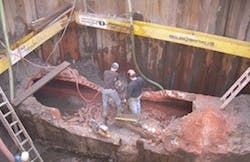In 2006, the Merrimac River flooded into two residential areas in a Massachusetts city. Twenty-five homes were damaged during the incident.
In the past, this city had partnered with Red Valve Company for flow-metering work. It called Red Valve again to discuss using Tideflex check valves in order to prevent future flooding in these areas.
Representatives from the city and Red Valve Company met to discuss their options and to create a solution. The resulting solution was the installation of a vault containing a 72-in. Tideflex Series TF-1 check valve and a 20-in. Tideflex Series TF-1 check valve. The 72-in. TF-1 would take the flow that comes from one residential area, while the 20-in. TF-1 would take the flow coming from the other community.
The Series TF-1 check valves can hold back the river water, but no water will flow through the valves until the differential pressure on the upstream side of the valve is greater. To remove standing water upstream of the TF-1 check valves while the river is at its highest level, the city purchased several pumps that would remove water that otherwise could not flow through the check valves.
The solution was a major success. In the spring of 2007, the Merrimac River flooded again. The Series TF-1 check valves held back the river, and the pumps removed excess water over the bank. This time, the homes in the residential areas did not suffer any water damage. Because of the installation’s success, the city has since purchased more TF-1 check valves to protect other neighborhoods in the vicinity.



